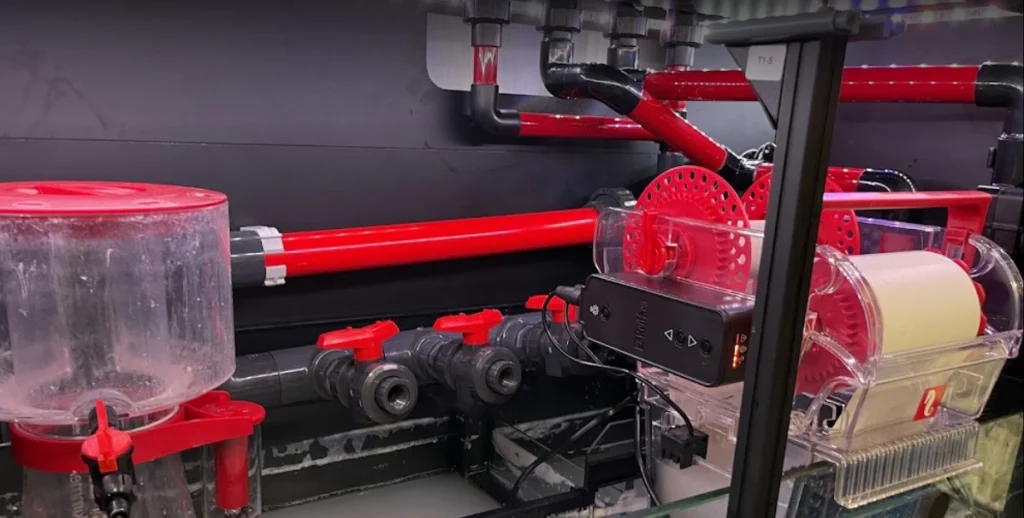The Ultimate Guide to Creating a Stunning Aquarium Setup: Step-by-Step Tips and Tricks
Are you ready to dive into the fascinating world of aquariums? Whether you’re a seasoned aquarist or a beginner looking to start your own underwater oasis, this ultimate guide is here to help you create a stunning aquarium setup. From selecting the perfect tank and choosing the right fish and plants, to mastering the art of water chemistry and creating a captivating aquascape, we’ve got you covered every step of the way. With our expert tips and tricks, you’ll learn how to create a thriving ecosystem that not only provides a beautiful centerpiece for your space, but also ensures the health and happiness of your aquatic companions. Get ready to unleash your creativity and embark on a rewarding journey into the mesmerizing world of aquarium keeping. Let’s dive in and discover the secrets to crafting a truly remarkable underwater paradise.

Choosing the Right Aquarium Size and Location
When it comes to setting up an aquarium, the first decision you’ll need to make is choosing the right size and location. The size of your aquarium will depend on several factors, including the available space in your home and the type of fish you plan to keep. It’s important to select a tank that provides enough room for your fish to swim and grow comfortably. Additionally, consider the weight of the tank when filled with water, as larger aquariums can be quite heavy and may require additional support.
The location of your aquarium is also crucial for its success. Avoid placing it in direct sunlight or near sources of heat, as this can cause temperature fluctuations and algae growth. Ideally, choose a spot that is away from high traffic areas to minimize stress for your fish. A stable and level surface is essential to ensure the safety of your aquarium and its inhabitants. Remember to leave enough space around the tank for maintenance and easy access.
Proper planning and consideration of these factors will help create an ideal environment for your aquarium and make it easier for you to maintain and enjoy.
Selecting the Best Aquarium Equipment and Supplies
Once you have determined the size and location of your aquarium, it’s time to select the necessary equipment and supplies. The right equipment is essential for maintaining a healthy and thriving aquarium ecosystem. Here are some key items to consider:
1. **Filtration System**: A good filtration system is crucial for keeping the water clean and free from harmful substances. There are three types of filtration: mechanical, chemical, and biological. Mechanical filtration removes physical debris, chemical filtration removes impurities through activated carbon, and biological filtration utilizes beneficial bacteria to break down waste.
2. **Heater and Thermometer**: Most tropical fish require a stable water temperature. A heater and thermometer are essential to maintain the optimal temperature range for your fish species.
3. **Lighting**: Aquarium lighting not only enhances the aesthetics of your tank but also provides the necessary light for plants and fish. Different types of lighting, such as LED or fluorescent, offer various benefits. Consider the needs of your aquatic plants and fish when selecting the appropriate lighting system.
4. **Substrate and Decorations**: The substrate, or the material at the bottom of the aquarium, provides a natural environment for plants and fish. Gravel, sand, or specialized substrates can be used, depending on your preferences and the needs of the fish and plants you have selected. Decorations, such as rocks, driftwood, and artificial plants, add visual interest and provide hiding places for your fish.
5. **Water Test Kit**: Regular water testing is essential for maintaining proper water chemistry. A water test kit will help you monitor parameters such as pH, ammonia, nitrite, and nitrate levels. This information is crucial for ensuring the health and well-being of your fish.
Remember to research and select high-quality equipment and supplies that are suitable for the size and requirements of your aquarium. Investing in reliable and efficient equipment will save you time and money in the long run.
Understanding the Importance of Water Quality and Filtration
Maintaining good water quality is vital for the health and longevity of your aquarium inhabitants. Fish and plants rely on clean and well-balanced water to thrive. Here are some key factors to consider for optimal water quality:
1. **Cycling**: Before adding fish to your aquarium, you need to establish a stable nitrogen cycle. This process involves the growth of beneficial bacteria that convert toxic ammonia into less harmful substances. Cycling can take several weeks, but it is essential for creating a healthy and stable environment for your fish.
2. **Water Parameters**: Different fish species have different water parameter requirements. Factors such as pH, temperature, hardness, and ammonia levels should be monitored regularly to ensure they are within the appropriate range for your fish. Use a water test kit to measure these parameters and make necessary adjustments if needed.
3. **Water Changes**: Regular water changes are necessary to remove accumulated toxins and maintain water quality. Aim for a monthly water change of 10-20% of the total volume. Use a siphon to remove debris from the substrate during water changes.
4. **Filtration**: As mentioned earlier, a good filtration system is essential for removing physical and chemical impurities from the water. Ensure that your filtration system is properly sized for your aquarium and that the filter media is regularly cleaned or replaced according to the manufacturer’s recommendations.
By understanding the importance of water quality and filtration, you can create a stable and healthy environment for your fish and plants. Regular monitoring and maintenance will help prevent common issues such as ammonia spikes and algae blooms.
Choosing the Right Substrate and Decorations for Your Aquarium
The substrate and decorations you choose for your aquarium play a crucial role in creating a visually appealing and functional environment. Here are some factors to consider when selecting the right substrate and decorations:
1. **Substrate**: The substrate serves as the foundation for your aquarium and provides a natural environment for plants and fish. Gravel, sand, and specialized substrates each have their advantages. Consider the needs of your fish and plants when selecting the appropriate substrate. For example, certain fish species prefer sandy bottoms, while others may require a substrate that supports plant growth.
2. **Decorations**: Decorations add visual interest to your aquarium and provide hiding places for your fish. Rocks, driftwood, and artificial plants are popular choices. Ensure that any decorations you choose are safe for your fish and do not alter water chemistry. Avoid sharp objects that may harm your fish or damage the aquarium.
3. **Aquascaping**: Aquascaping is the art of arranging plants, rocks, and other elements in your aquarium to create a visually pleasing layout. Consider the principles of design, such as balance, proportion, and focal points, when planning your aquascape. Research different aquascaping styles, such as Dutch or Nature Aquarium, for inspiration.
Remember to create a harmonious and functional layout that provides ample swimming space for your fish while allowing for the growth and maintenance of your aquatic plants.
Selecting the Appropriate Plants and Fish for Your Aquarium
The selection of plants and fish for your aquarium is an exciting and important step in creating a stunning setup. Here are some considerations when choosing the right plants and fish:
1. **Plants**: Live aquatic plants not only enhance the visual appeal of your aquarium but also provide numerous benefits. They help oxygenate the water, absorb excess nutrients, and provide natural hiding places for your fish. Research different plant species and their care requirements, such as lighting and nutrient needs, before making your selection. Consider your aquarium’s size, lighting, and CO2 injection (if applicable) when choosing plants.
2. **Fish**: When selecting fish for your aquarium, consider their compatibility, size, and care requirements. Avoid overcrowding and ensure that the fish species you choose can coexist peacefully. Research the preferred water parameters, diet, and behavior of each fish species to provide a suitable environment. Consider the needs of your plants and fish to create a balanced ecosystem.
It’s important to note that some fish and plants may have specific care requirements or may not be compatible with each other. Research thoroughly and consult with knowledgeable experts or reputable sources when making your selections.
Setting Up the Aquarium: Step-by-Step Guide
Now that you have chosen the right size, location, equipment, substrate, decorations, and inhabitants for your aquarium, it’s time to set it up. Follow these step-by-step instructions for a successful aquarium setup:
1. **Clean the Tank**: Rinse the aquarium with warm water to remove any dust or contaminants. Avoid using soap or cleaning agents, as they can be harmful to your fish.
2. **Install Equipment**: Install the filtration system, heater, and lighting according to the manufacturer’s instructions. Ensure that all equipment is properly positioned and securely attached.
3. **Add Substrate and Decorations**: Carefully add the chosen substrate to the aquarium. Rinse the substrate beforehand to remove any debris. Arrange the decorations according to your aquascaping plan, considering the needs of your fish and plants.
4. **Add Water**: Fill the aquarium with water. Use a plate or a bowl to gently pour the water onto the substrate to avoid disturbing it. Fill the tank about halfway, and then add any water treatments, such as dechlorinator, as recommended for your water source.
5. **Cycle the Tank**: Start the nitrogen cycle by adding a source of ammonia, such as fish food or pure ammonia. Monitor the water parameters and allow the beneficial bacteria to establish for several weeks before adding fish.
6. **Introduce Plants**: Carefully plant the aquatic plants in the substrate. Trim any damaged leaves or roots before planting. Ensure that the plants are properly spaced to allow for their growth.
7. **Introduce Fish**: Once the nitrogen cycle is established and the water parameters are stable, you can gradually introduce your fish to the aquarium. Acclimate them slowly to prevent shock by floating their bag in the tank and gradually adding aquarium water over time. Release the fish into the tank after acclimation.
8. **Monitor and Adjust**: Regularly monitor water parameters, temperature, and the health of your fish and plants. Make necessary adjustments to maintain a healthy and balanced aquarium environment.
By following these steps, you can set up an aquarium that provides a beautiful and thriving habitat for your aquatic companions.
Maintaining a Healthy and Beautiful Aquarium
Setting up an aquarium is just the beginning of your journey into the world of aquarium keeping. Regular maintenance is crucial for keeping your aquarium healthy and beautiful. Here are some essential maintenance tasks:
1. **Water Changes**: Regular water changes are necessary to remove toxins and maintain water quality. Aim for a monthly water change of 10-20% of the total volume. Use a siphon to remove debris from the substrate during water changes.
2. **Cleaning**: Regularly clean the glass, decorations, and equipment to remove algae and debris. Use an algae scraper or sponge to clean the glass, and rinse decorations and equipment with aquarium water.
3. **Trimming and Pruning**: As your plants grow, they may require trimming and pruning to maintain their shape and prevent overcrowding. Use sharp scissors or aquascaping tools to trim any dead or overgrown plant parts.
4. **Feeding**: Feed your fish a balanced diet suitable for their species. Avoid overfeeding, as it can lead to poor water quality and health issues for your fish. Remove any uneaten food to prevent decomposition.
5. **Maintenance Schedule**: Create a maintenance schedule to ensure that all necessary tasks are performed regularly. This will help you stay organized and prevent any neglect or oversight.
Regular maintenance is essential for the long-term success of your aquarium. By dedicating time to care for your fish, plants, and equipment, you will be rewarded with a vibrant and beautiful underwater oasis.
Troubleshooting Common Aquarium Setup Problems
Even with careful planning and maintenance, aquariums can sometimes encounter problems. Here are some common issues and troubleshooting tips:
1. **Cloudy Water**: Cloudy water is often caused by a bacterial bloom or excessive organic matter. Perform a water change and ensure that your filtration system is functioning properly. Avoid overfeeding and remove any decaying plants or excess waste.
2. **Algae Growth**: Algae growth is a common issue in aquariums. To control algae, ensure that your lighting duration and intensity are appropriate for your plants. Avoid overfeeding and maintain proper water parameters. Introduce algae-eating fish or snails to help control algae growth.
3. **Ammonia Spikes**: Ammonia spikes can occur during the initial stages of the nitrogen cycle or as a result of overfeeding or inadequate filtration. Perform a water change and monitor water parameters closely. Adjust feeding habits and ensure that your filtration system is properly sized for your aquarium.
4. **Fish Compatibility Issues**: Aggressive or incompatible fish can cause stress and harm to each other. Research the behavior and compatibility of different fish species before adding them to your aquarium. Provide ample hiding places and territories for your fish to minimize aggression.
If you encounter any issues with your aquarium, it’s important to identify the root cause and take appropriate action promptly. Seek advice from experienced aquarists or consult reputable sources to address the problem effectively.
Tips and Tricks for Enhancing the Aesthetics of Your Aquarium
Creating a stunning aquarium setup goes beyond the basics. Here are some tips and tricks to take your aquarium to the next level:
1. **Aquascaping Techniques**: Experiment with different aquascaping techniques, such as layering, focal points, and creating depth. Use rocks, driftwood, and plants to create visually appealing layouts.
2. **Colorful Fish and Plants**: Consider adding colorful fish and plants to create a vibrant and eye-catching aquarium. Research different species and varieties to find those that suit your preferences.
3. **Backgrounds**: Use a background to enhance the visual impact of your aquarium. Choose from various options, such as solid colors, underwater scenes, or natural landscapes, to create depth and add visual interest.
4. **Artificial Decorations**: Artificial decorations, such as realistic-looking rocks or plants, can provide a low-maintenance alternative to live plants and rock formations. They can be used to create dramatic and eye-catching focal points.
5. **Maintenance Tools**: Invest in quality maintenance tools, such as algae scrapers, tweezers, and aquascaping scissors. These tools will make routine maintenance tasks easier and more efficient.
Remember to balance aesthetics with the well-being of your fish and plants. Creating a visually stunning aquarium should not compromise their health and happiness.
Conclusion
Creating a stunning aquarium setup is a rewarding and creative endeavor. By following the step-by-step tips and tricks in this ultimate guide, you’ll be well on your way to crafting a remarkable underwater paradise. From selecting the right
If you're in the Murfreesboro Area

Please stop by Animal City on NW Broad St. They have high quality fish and their staff is more than helpful!
If you're in the Nashville Area

Visit Aquatic Critter on Nolensville Road. Huge selection of fish and equipment, and their staff is very knowgledable!



